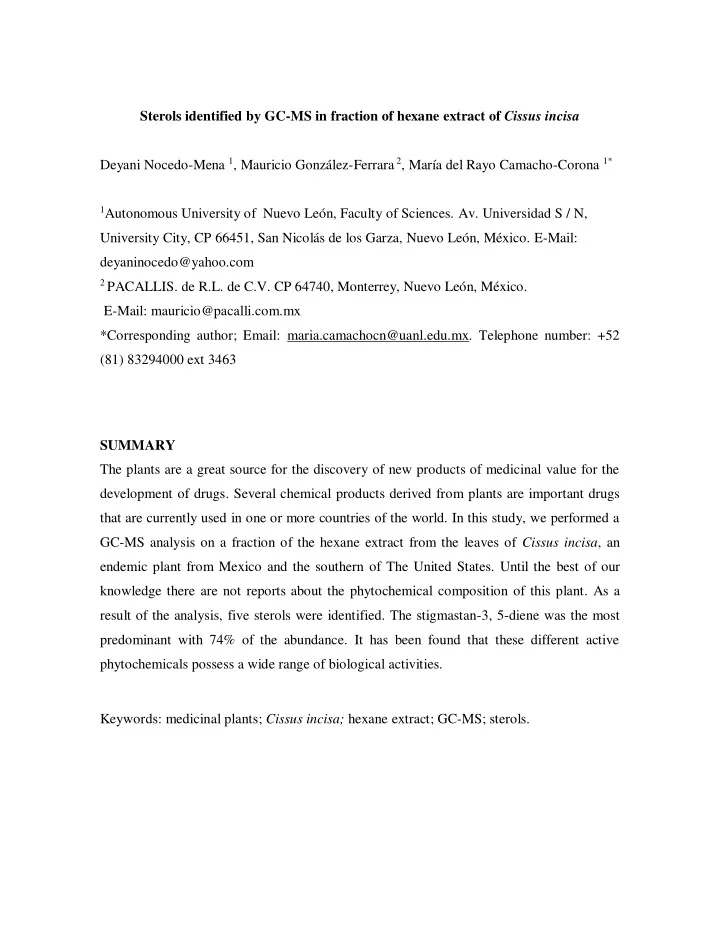

Sterols identified by GC-MS in fraction of hexane extract of Cissus incisa Deyani Nocedo-Mena 1 , Mauricio González-Ferrara 2 , María del Rayo Camacho-Corona 1* 1 Autonomous University of Nuevo León, Faculty of Sciences. Av. Universidad S / N, University City, CP 66451, San Nicolás de los Garza, Nuevo León, México. E-Mail: deyaninocedo@yahoo.com 2 PACALLIS. de R.L. de C.V. CP 64740, Monterrey, Nuevo León, México. E-Mail: mauricio@pacalli.com.mx *Corresponding author; Email: maria.camachocn@uanl.edu.mx. Telephone number: +52 (81) 83294000 ext 3463 SUMMARY The plants are a great source for the discovery of new products of medicinal value for the development of drugs. Several chemical products derived from plants are important drugs that are currently used in one or more countries of the world. In this study, we performed a GC-MS analysis on a fraction of the hexane extract from the leaves of Cissus incisa , an endemic plant from Mexico and the southern of The United States. Until the best of our knowledge there are not reports about the phytochemical composition of this plant. As a result of the analysis, five sterols were identified. The stigmastan-3, 5-diene was the most predominant with 74% of the abundance. It has been found that these different active phytochemicals possess a wide range of biological activities. Keywords: medicinal plants; Cissus incisa; hexane extract; GC-MS; sterols.
RESULTS Table 1. GC-MS of a sample of the hexane extract of C. incisa leaves % of Molecular Retention times Compounds Abundance formula (3S,10R,13R)-17-((2R,5S,E)-5,6-dimethylhept- 3-en-2-yl)-10,13-dimethyl- C 30 H 48 O 2 113.681 1.210% 2,3,4,7,8,9,10,11,12,13,14,15,16,17- tetradecahydro-1H-cyclopenta[a]phenanthren- 3-yl acetate (E)-17-(5,6-dimethylhept-3-en-2-yl)-10,13- dimethyl-2,3,4,9,10,11,12,13,14,15,16,17- C 30 H 46 O 2 114.811 1.079% dodecahydro-1H-cyclopenta[a]phenanthren-3- yl acetate C 31 H 52 O 2 Stigmata acetate-5-en-3- β -yl 115.665 9.155% (E)-17-(5-ethyl-6-methylhept-3-en-2-yl)-10,13- C 31 H 50 O 2 116.604 7.761% dimethyl-2,3,4,7,8,9,10,11,12,13,14,15,16,17- tetradecahydro-1H-cyclopenta[a]phenanthren- 3-yl acetate 17-(5-ethyl-6-methylheptan-2-yl)-10,13- C 29 H 48 118.851 74.897% dimethyl-2,7,8,9,10,11,12,13,14,15,16,17- dodecahydro-1H-cyclopenta[a]phenanthrene
C 31 H 52 O 2 C 30 H 48 O 2 PM:456 g/mol PM:440 g/mol C 31 H 50 O 2 C 30 H 46 O 2 PM:454 g/mol PM:438 g/mol C 29 H 48 PM:396 g/mol Figure 1. Chemical structure of the sterols characterized by GC-MS of the sample of the hexane extract of C. incisa leaves CONCLUSIONS In the chromatogram obtained, peaks with different retention times and area were observed. Of which four acetylated sterols and one stigmastene were characterized, this being the most abundant. Sterols are very abundant and their function is to maintain the structure and
functioning of cell membranes. They have also been widely studied and they have been determined antimicrobial , anticancer properties, among others. ACKNOWLEDGEMENTS DNM thanks CONACYT-MEXICO for the scholarship (605522) to carry out her PhD studies in the Faculty of Chemical Sciences, UANL. REFERENCES 1. Alvarado V á zquez, M. A., Rocha Estrada, A. and Moreno Lim ó n, S. From the lechuguilla to the vegetable biofilms: the useful plants of Nuevo Leoón. (Autonomous University of Nuevo León, 2010). 2. Pérez Ibáñez, N. M. Terpens. In Pharmacognosy and Herbal Medicines (2014). 3. Li, H. Li, H., Zhao, X., Wang, J., Dong, Y.,Meng, S., Li, R., Niu, X., Deng, X. β - sitosterol interacts with pneumolysin to prevent Streptococcus pneumoniae infection. Sci. Rep. 5, 1 – 9 (2015). 4. Rajavel, T., Mohankumar, R., Archunan, G., Ruckmani, K. and Devi, K. P. Beta sitosterol and Daucosterol (phytosterols identified in Grewia tiliaefolia ) perturbs cell cycle and induces apoptotic cell death in A549 cells. Sci. Rep. 7, 1 – 15 (2017).
Recommend
More recommend